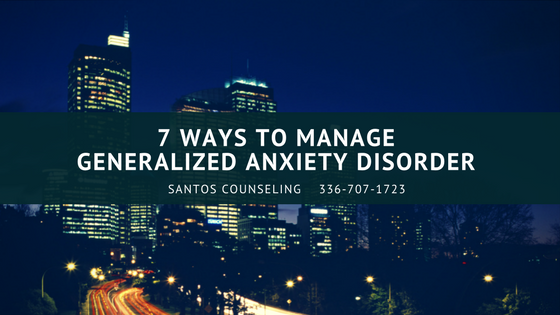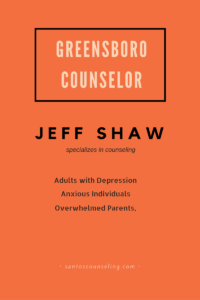Ways to manage Generalize Anxiety Disorder
I love working with anxious people. I have a little bit of anxiety myself.
Generalized Anxiety Disorder is like a tooth ache that hurts no matter what you do. You can rub numbing cream on it, but it’ll still hurt. It’s always present and in some ways hindering.
As a counselor, I enjoy working with adults and teens struggling with anxiety disorder. This article supports individuals experiencing the challenges that accompany anxiety by providing a simply definition to anxiety, common symptoms of anxiety and strategies to manage anxiety and worry.
Anxiety sneaks up on you when you are in uncomfortable situations such as during an important presentation or when under pressure at work. Anxiety impacts you during the everyday “normal” situations, such as when you are running late to work or an appointment.
Common symptoms of Anxiety:
- Problems focusing or concentrating.
- Difficulty making decisions or making up your mind.
- Daydreaming or feeling as if you are in a “trance” like state.
- Hand tremors.
- Overly sweaty.
- Nervous.
- Feeling on edge.
- Easily provoked or agitated.
7 – Ways to manage generalized anxiety disorder:
1 – Practice Meditation
With meditation you have several options to choose from. You can join a meditation class or self-help book – something related to yoga or Pilates will do just fine. Or if you are squeezing for time, then short periods of meditation can work as well. A simple strategy is to give yourself 5 to 10 minutes in the car, in the bathroom, or pretty much anywhere that you can be alone. During this time – allow yourself to take 4 to 6 deep breaths.
This strategy helps you:
- Simply reset the clock of stress.
- Catch a break.
- Regain your sanity.
- Regain control over the situation.
- Manage your stress and anxiety.
2 – Journal or Writing or Recording
I don’t like to limit the option to only writing – as some people simply do not enjoy writing. With today’s technology – there are options such as typing, texting, audio or video recording or anything that you can come up with that documents your thoughts. You can document your thoughts by recording them into your smartphone or adding an Evernote app to your phone to jot down thoughts during the day.
Ideally, it’s best practice to spend at minimum 10 minutes – while later reflecting back on how you feel now versus then. One small tip: different environments can bring out varying emotions. For instance, documenting in your car outside of work can be very different then at home in your room.
This strategy can help:
- Reduce tension or stress brought on by the day.
- Focus and concentrate on what’s important.
- Reduce anxiety or worry.
- Anxiety self-help book.
3 – Say YES more often
In some ways, I’m kind of quoting the movie “Yes Man” with Jim Carrey but only in thought. The purpose of saying “yes: is to help with gratitude and control. We often travel through life with a boulder over our heads. The boulder represents stress, anxiety, depression and many more troubling emotions or distressful symptoms. Yet, during the minimal times that we allow ourselves to let go of control their tends to evolve positive outcomes.
Saying “Yes” – has limits. Be smart on what you say “yes” to, while making sure that when you do it helps with your overall emotional stability.
This strategy helps with:
- Allowing you to feel happier.
- Providing more opportunities to experience positive thoughts.
- Feeling a sense of accomplishment.
4 – Learn to say NO
Well – I don’t think there is a movie for saying “no”. This technique works in the same manner as the one above. You may be the type of person that feels obligated to say “yes” and when you do not say “yes” you experience an uncomfortable feeling. A feeling that makes you feel as if you did something wrong or let someone down. This feeling may be associated with anxiety or personal frustration from what you said. Just say “no”. Think about what it is that the other person is asking you – process it – and if you find it harmful or in any way negative to your mental wellbeing “say no”.
This strategy help with:
- Learning to have a “voice” and feel empowered.
- Creating new a new self-care skill.
- Creating healthy boundaries.
5 – Self-Care “Treat yourself”
Just as the title says – “treat yourself”. Make it part of your weekly routine – honestly- I suggest daily routine. Why not? You work hard each day. Why not present some sort of “treat” = “self-care” for yourself? The healthier and happier you are the better you will perform, the better you will feel and the happier people around you will feel. Trust me, if you are an exhausted mother – your husband or kids will notice.
Ways to include self-care in life:
- 10 minutes – 10 times per day give yourself some sort of treat. This can be listening to a few of your favorite tunes or bundling up a few 10 minutes to get your nails done.
- Get your nails done once a month.
- Go for a walk.
- Have someone give you a massage.
- Read your favorite book with no distractions.
- Ask your spouse to watch the kids while you lock yourself in your room with Netflix.
6 – Short-term relief for Anxiety
- Deep breathing exercise – 4x4x4 – Inhale for a duration of 4 seconds – hold it in for 4 seconds – release for a duration of 4 seconds.
- Talk to someone – pick up your phone and call someone you trust to vent on what just took place. Talking about the anxiety allows the mind then the body to feel release from the binding anxiety.
- Eye of the tiger – visualize yourself at your ideal location. This could be picturing yourself at the beach holding a margarita while viewing the wave’s crash in front of you.
- Reflection – Internally walk back to what just took place and how you reacted. Admitting the truth of the situation allows a similar reaction to that experienced when venting.
7 – Anxiety Prevention Exercises
- Stay ahead of the game by understanding your “warning signs”. Make a list using your phone or on a sheet of paper to recognize what your warning signs are.
- Live Healthy – be mindful of what you eat or drink and how that in turn impacts your anxiety. For instance, if you find that your anxiety warning sign is driven by feeling on “edge” – coffee or caffeinated beverages may need to be monitored, reduced or eliminated.
- Learn to say “no” – Creating a role that is surrounded by “assertiveness” will help you feel empowered – this in turn supports your ability to manage anxiety.
- Preparation – Become knowledgeable as to which situations lead to what outcome. By doing so – you will feel in control and ahead of the game.
- Resolve past issues that currently impact you today. This may require time to reflect and associate how past issues impact today’s decisions.
- Take care of yourself
The more you understand yourself the better you will handle the challenges of anxiety.
Juan Santos is a Licensed Professional Counselor and book author. He specializes in counseling anxious adults and teens in Greensboro and Winston Salem, NC.




